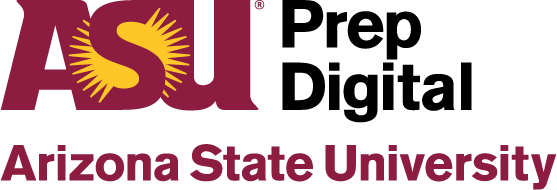By: Shannon Mo
chairs circled together outside Coldstone Creamery are no exception. This is when and
where the Phoenix Valley Sign Language Social takes place–and where passionate
signers, deaf and hearing alike–congregate for two hours every Thursday. As a current
ASL 1B student, I had the fantastic opportunity to meet ASU Prep Digital’s own Mrs.
Emma Horlick here to learn more about the deaf community and put what I’ve learned
in class into practice.
What’s your favorite part of coming to these ASL socials, and how often do
you attend?
Horlick: Deaf meet-ups are super important; deaf communities value
community! When you take the time to learn their language and be a part of
their community–because it’s their language and not ours, and we have to
make sure we are aware of that–they are really excited about it. I try to go to
one every month if not every week. Desert Ridge is the best one in the
Valley–there’s always a good array of students, deaf adults, interpreters–
the whole ASL community is usually here! The meet-up that takes place in
Peoria, near the Arrowhead Mall on the third Friday of every month is also
a favorite.
It being my very first time attending a deaf meet-up, I have to admit I was slightly
overwhelmed–but the excitement of meeting new people, connecting with the deaf
community, and sharing my love for the language with others was worth the initial
anxiety.
Why did you decide to teach ASL, particularly ASL 1A?
Horlick: I took ASL in college, pursuing a career in interpreting. Life
happened, and I moved to Germany where I couldn’t use ASL. But after
moving [to Arizona], I found a way to combine my passions for teaching
(especially high school students), and ASL.
because many students come into the class thinking it’s an easy language to
learn–that it’s just English translated into handshapes, when really ASL is
an entirely different language with its own grammar, syntax, word order,
and facial expressions.
ASL? Or is it a passion that grew over time?
Horlick: My brother has cerebral palsy, so I always knew growing up that I
was passionate about accessibility and helping disabled people; I learned
pretty soon that deaf people aren’t disabled, but I always wanted to help in
that world. After taking ASL in college, I completely fell in love, and
switched my major from nursing to sign-language interpreting.
Horlick: There’s the hearing culture answer of like, you can sign
underwater, or if you go to a sporting event you can sign across the
stadium, or if it’s really loud at a school dance, you can sign to each other;
but the real-world answer is: sign language will help you in any career that
you pursue; at some point, you’re going to run into a deaf person, and you
can be the person that makes your career area accessible. Learning sign is a
great way to open up a new world for yourself and expand your abilities to
communicate.
At the meet-up, I introduced myself to the group and felt immediately welcomed.
Although, equipped with a limited vocabulary, it wasn’t always easy to navigate
conversations, I found that everybody was supportive and encouraging. We shared a
moment of ice-breaking laughter when Mrs. Horlick mentioned that some students
make the unfortunately common mistake of signing ‘nice to date you’ instead of ‘nice to
meet you’, signs that are alarmingly similar.
What’s your favorite part about teaching ASL?
Horlick: Hanging out with my students during Friday live lessons; I look
forward to them every week and I try to make them fun and engaging! It’s
just as fun seeing you guys grow and have your ‘a-ha moments’.
language. Again, it’s not just English translated into sign; ASL is a
completely different language.
Do you have any advice for students beginning (or considering) ASL?
Horlick: If you’re going to learn and you want to be successful, find deaf
events around you. Using the language—with deaf people and other
students, will help you learn. That’s like the scary answer–my other answer
is that ASL is a very visual language, so don’t be afraid of recording yourself
signing or showing it to teachers for feedback–we just want to help and
support you!
By 9:00, the chairs are put back in their groups around rectangular tables. We wave
goodbye, and I am imparted a few final words of wisdom from one of the meet-up
regulars: “Don’t give up; the more you sign, the longer you practice, the better you’ll
become!”

